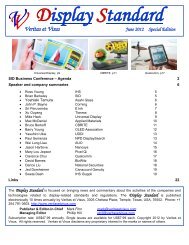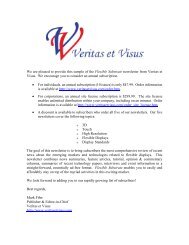Create successful ePaper yourself
Turn your PDF publications into a flip-book with our unique Google optimized e-Paper software.
<strong>Veritas</strong> <strong>et</strong> <strong>Visus</strong> <strong>Display</strong> <strong>Standard</strong> February 2009<br />
Meko/<strong>Display</strong>Search <strong>Display</strong> Forum 2008<br />
November 4-5, Düsseldorf, Germany<br />
In this second report of two, Phillip Hill covers this joint conference with presentations from Lenovo,<br />
Fujitsu Siemens Computers, PricewaterhouseCoopers, and EPEAT<br />
The Duty Issue… A Never Ending Story?<br />
Jos Verstraten, PricewaterhouseCoopers, London, England<br />
Verstraten first went into the background of the monitor import duty levels. The current state of play is that all<br />
monitors are classified in “8528”. For non-CRT’s: 8528.51: of a kind solely or principally used in an automatic data<br />
processing system of heading 8471 (0%); 8528.59: other non-wide screens up to 19 inches (duty suspension 0%);<br />
others 14%. Other issues are the continuing discussion to expand duty suspension (+19 inches), and pending court<br />
cases. Regarding the pending case at the European Court of Justice (ECJ) involving Kamino International Logistics<br />
BV, questions raised by the Dutch Supreme Court were:<br />
� Must Note 5 to Chapter 84 be interpr<strong>et</strong>ed as meaning that a color monitor which can display both signals<br />
from an automatic data processing machine and from other sources is excluded from classification under<br />
heading 8471?<br />
� If classification in heading 8471 is not excluded, on the basis of which criteria must it then be<br />
d<strong>et</strong>ermined wh<strong>et</strong>her it is a unit of the sort that is solely or principally used in an automatic dataprocessing<br />
system?<br />
� Does the scope of application of Commission Regulation (EC) No. 754/2004 of 21 April 2004 on the<br />
classification of certain goods extend to the monitor at issue and, if so, in light of the answers to the first<br />
and second questions, is that regulation valid?<br />
The opinion of the Advocate General issued on Sept 10, 2008 is that “solely or principally” does not equal “solely”.<br />
The Commission and a few member states tend to interpr<strong>et</strong> ITA restrictions in an effort to limit the range of<br />
products that benefit from the ITA duty exemption. The classification of monitors is complex (duty suspension,<br />
classification Regulation 493/2005) and “principally” should be read as “normally”. Classification Regulation<br />
754/2004 cannot directly be applied to this case seen that there are considerable technical differences in products<br />
nor can it be applied by analogy. Verstraten said that if ECJ verdict is in line with opinion of Advocate General, it<br />
might be groundbreaking with the option to claim back duties paid. It re-opens discussions on the current<br />
classification with additional legal (court) cases likely.<br />
EPEAT Overview<br />
Jeff Omelchuck, EPEAT (EPA), Washington, District of Columbia<br />
EPEAT (Electronic Product Environmental Assessment Tool) is a system from the US Environmental Protection<br />
Agency to help purchasers in the public and private sectors evaluate, compare and select desktop computers,<br />
notebooks and monitors based on their environmental attributes. EPEAT also provides a clear and consistent s<strong>et</strong> of<br />
performance criteria for the design of products, and provides an opportunity for manufacturers to secure mark<strong>et</strong><br />
recognition for efforts to reduce the environmental impact of its products. The EPEAT Registry includes products<br />
that have been declared by their manufacturers to be in conformance with the environmental performance standard<br />
32






